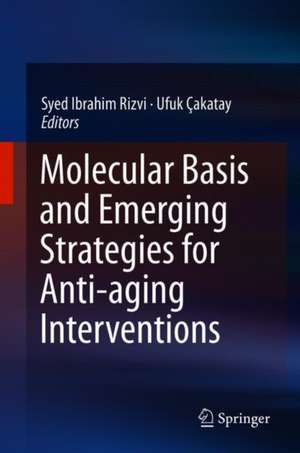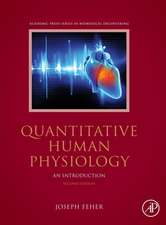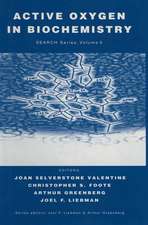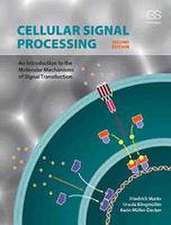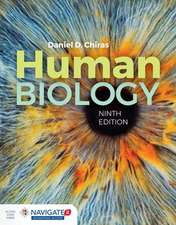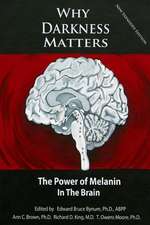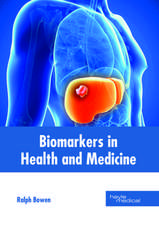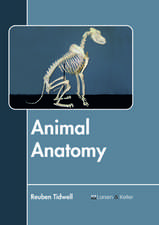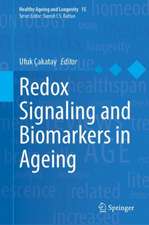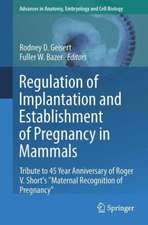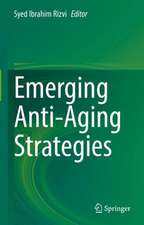Molecular Basis and Emerging Strategies for Anti-aging Interventions
Editat de Syed Ibrahim Rizvi, Ufuk Çakatayen Limba Engleză Hardback – 15 noi 2018
Preț: 1206.44 lei
Preț vechi: 1269.93 lei
-5% Nou
Puncte Express: 1810
Preț estimativ în valută:
230.84€ • 241.05$ • 190.63£
230.84€ • 241.05$ • 190.63£
Carte tipărită la comandă
Livrare economică 11-17 aprilie
Preluare comenzi: 021 569.72.76
Specificații
ISBN-13: 9789811316982
ISBN-10: 9811316988
Pagini: 463
Ilustrații: XIV, 386 p. 67 illus., 34 illus. in color.
Dimensiuni: 155 x 235 mm
Ediția:1st ed. 2018
Editura: Springer Nature Singapore
Colecția Springer
Locul publicării:Singapore, Singapore
ISBN-10: 9811316988
Pagini: 463
Ilustrații: XIV, 386 p. 67 illus., 34 illus. in color.
Dimensiuni: 155 x 235 mm
Ediția:1st ed. 2018
Editura: Springer Nature Singapore
Colecția Springer
Locul publicării:Singapore, Singapore
Cuprins
Chapter 1. Hormesis and Hormetic drugs for healthy ageing and longevity.- Chapter 2. Intermittent fasting dietary restriction as a geroprotector.-Chapter 3. Anti-aging properties of Mediterranean diet components in human.- Chapter 4. Activation of plasma membrane redox system: A novel anti-aging strategy.- Chapter 5. Beneficial effects of alternate-day fasting and calorie restriction on the risk factors for age related diseases.-Chapter 6. Role of phytochemicals in eliciting longevity genes.- Chapter 7. Autophagy induction: A promising anti-aging strategy.- Chapter 8. The potential role of stem cell reprogramming in anti-aging.- Chapter 9. Anti-aging strategies based on telomerase activity.- Chapter 10. Epigenetic modification is an attractive target for therapeutic anti-aging intervention.- Chapter 11. Antioxidants for health and longevity.- Chapter 12. Current approaches of anti-inflammatory dependent anti-aging strategies.- Chapter 13. Anti-aging therapeutics based on rapalogs and mTOR inhibitors Exercise-induced anti-aging mechanisms.- Chapter 14. AMPK activation: An emerging anti-aging strategy.- Chapter 15. Sirtuin activators and brain aging.- Chapter 16. Glycolytic inhibitors as tools for developing caloric restriction mimetics.- Chapter 17. Novel classification perspective of geroprotective and senolytic drugs as an anti-aging strategy.- Chapter 18. The place of geroprotective agents in life quality and longevity of companion animals.- Chapter 19. Management of sarcopenia for successful aging.- Chapter 20. Impact of sarcopenia and sarcopenic obesity in healthy aging.- Chapter 21. Klotho levels may be an innovative approach for mitigating age-related diseases.- Chapter 22. Melatonin and its anti-aging activity.
Notă biografică
Dr. Syed Ibrahim Rizvi is a Professor of Biochemistry at the University of Allahabad, India. He has been a visiting Professor at several universities including the University of Athens (Greece), University of Nice (France), University of Pisa, University of Milan, University of Rome (Italy), Istanbul University (Turkey), Research Centre for Natural Sciences, Budapest (Hungary) and Bangladesh University of Health Sciences, Dhaka. Prof. Rizvi is a grantee of the International Foundation for Science, Sweden. His research interests include aging mechanisms, anti-aging interventions, metabolic diseases, and natural products. To date, he has published 145 research papers, 10 book chapters and a large number of popular science articles. He has been awarded fellowships/grants by the European Molecular Biology Organisation (EMBO), Federation of European Biochemical Societies (FEBS), International Cell Research Organisation, Organization for the Prevention of Chemical Weapons (OPCW), the Hague (Netherlands), Department of Science and Technology, Govt. of India, and University Grants Commission, India. He has received the Young Scientist Project Award from the Department of Science and Technology, Govt. of India and was conferred the Academic Excellence Award by the University of Allahabad in 2016. Prof. Rizvi serves on the editorial/review boards of several leading research journals, and his work has been highlighted in the BBC (London) and other print and TV media. Prof Rizvi has 30 years of teaching/research experience.
Dr. Ufuk Çakatay is a senior scientist at the Department of Medical Biochemistry, Cerrahpaşa Faculty of Medicine, Istanbul University. Previously, he worked as an Associate Professor at the Central Laboratory of Clinical Biochemistry, Istanbul Faculty of Medicine. He graduated from the Department of Biology, Faculty of Science and received his Ph.D. degree from the Department of Medical Biochemistry, Cerrahpaşa Faculty of Medicine. His research interests include the optimization of bioanalytic methods for measuring oxidative stress, experimental animal models of aging, and age-related disorders. He has a long-standing interest in various protein oxidation biomarkers such as protein carbonyl groups, protein hydroperoxides, advanced oxidation protein products, dityrosine, and nitrotyrosine. Professor Çakatay has authored more than 80 publications, which include research papers, book chapters, editorials and invited reviews on free radical biology, aging, diabetes, and biological activity of alpha-lipoic acid. He has served as a guest editor, referee or member of the editorial board for more than 50 journals. He has received various prestigious awards such as the top reviewer award from Elsevier Science Publishing (2008) and serves on Istanbul University’s Committee on Animal Research and Ethics.
Dr. Ufuk Çakatay is a senior scientist at the Department of Medical Biochemistry, Cerrahpaşa Faculty of Medicine, Istanbul University. Previously, he worked as an Associate Professor at the Central Laboratory of Clinical Biochemistry, Istanbul Faculty of Medicine. He graduated from the Department of Biology, Faculty of Science and received his Ph.D. degree from the Department of Medical Biochemistry, Cerrahpaşa Faculty of Medicine. His research interests include the optimization of bioanalytic methods for measuring oxidative stress, experimental animal models of aging, and age-related disorders. He has a long-standing interest in various protein oxidation biomarkers such as protein carbonyl groups, protein hydroperoxides, advanced oxidation protein products, dityrosine, and nitrotyrosine. Professor Çakatay has authored more than 80 publications, which include research papers, book chapters, editorials and invited reviews on free radical biology, aging, diabetes, and biological activity of alpha-lipoic acid. He has served as a guest editor, referee or member of the editorial board for more than 50 journals. He has received various prestigious awards such as the top reviewer award from Elsevier Science Publishing (2008) and serves on Istanbul University’s Committee on Animal Research and Ethics.
Textul de pe ultima copertă
This book describes the nature of aging, age-related disorders, and the molecular principles of emerging strategies for anti-aging interventions, while also discussing the discovery of targets for geroprotective drugs. Although significant medical advances in the treatment and eradication of life-threatening conditions such as cardiovascular and infectious disease have been made over the past five decades, the prevalence of age-related disorders still remains high in older populations. Intervening into aging is the next frontier in contemporary medicine, and will be of increasing importance over time, as other sources of poor health are combated more and more successfully. Given the universal interest in anti-aging strategies, the book will appeal to a very broad audience. It addresses a diverse range of anti-aging interventions – including stem cells, autophagy, senolytics, anti-inflammatory methods, and telomerase induction – that will be of interest to scientists and researchersfrom various disciplines in the life sciences.
Caracteristici
The book provides a compilation of major approaches on current anti-aging interventions It provides the current understanding of the underlying principle, possible target, implementation approach and efficacy of the various anti-aging strategies It highlights the use of various geroprotectives and senolytics as an anti-aging drugs
